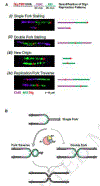Imaging cellular responses to antigen tagged DNA damage
- PMID: 30166246
- PMCID: PMC6340790
- DOI: 10.1016/j.dnarep.2018.08.023
Imaging cellular responses to antigen tagged DNA damage
Abstract
Repair pathways of covalent DNA damage are understood in considerable detail due to decades of brilliant biochemical studies by many investigators. An important feature of these experiments is the defined adduct location on oligonucleotide or plasmid substrates that are incubated with purified proteins or cell free extracts. With some exceptions, this certainty is lost when the inquiry shifts to the response of living mammalian cells to the same adducts in genomic DNA. This reflects the limitation of assays, such as those based on immunofluorescence, that are widely used to follow responding proteins in cells exposed to a DNA reactive compound. The lack of effective reagents for adduct detection means that the proximity between responding proteins and an adduct must be assumed. Since these assumptions can be incorrect, models based on in vitro systems may fail to account for observations made in vivo. Here we discuss the use of a detection tag to address the problem of lesion location, as illustrated by our recent work on replication dependent and independent responses to interstrand crosslinks.
Keywords: Antigen tag; DNA damage response; Interstrand crosslink; Replication independent repair; Replication stress.
Copyright © 2018 Elsevier B.V. All rights reserved.
Conflict of interest statement
Conflicts of interest
There are no conflicts of interest
Figures



References
-
- Lindahl T. The Intrinsic Fragility of DNA (Nobel Lecture), Angew.Chem.Int.Ed Engl, 55, (2016) 8528–8534. - PubMed
Publication types
MeSH terms
Substances
Grants and funding
LinkOut - more resources
Full Text Sources
Other Literature Sources

